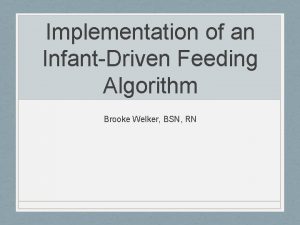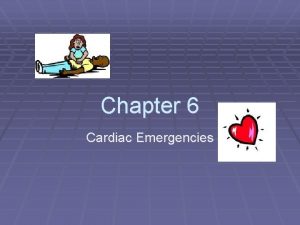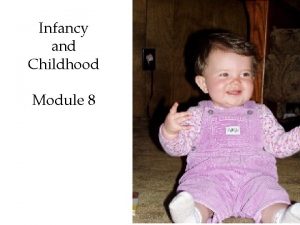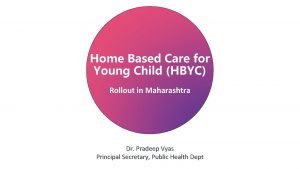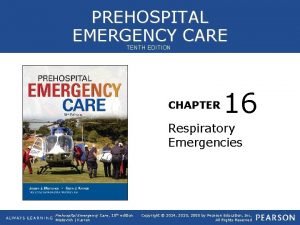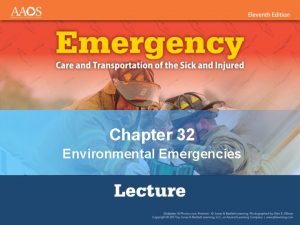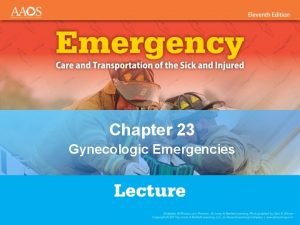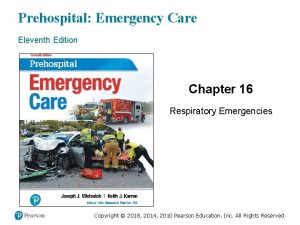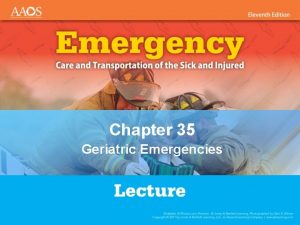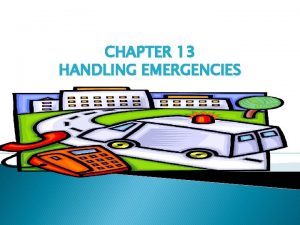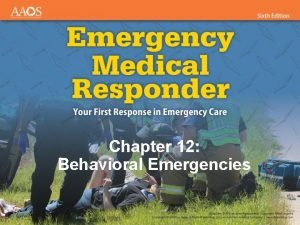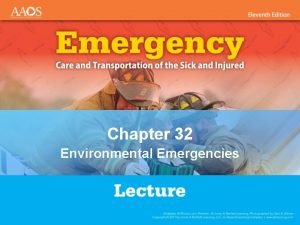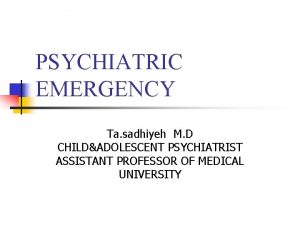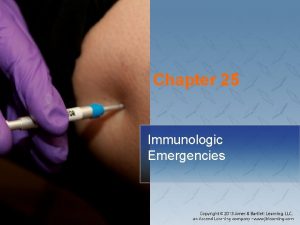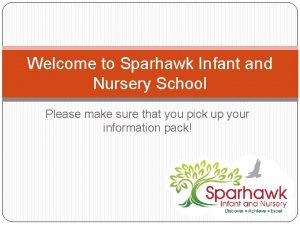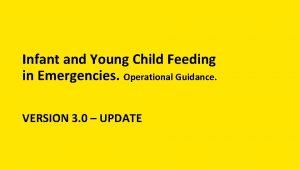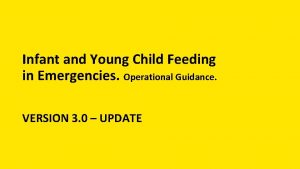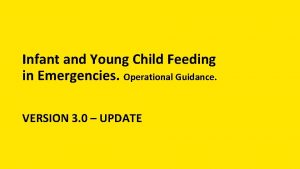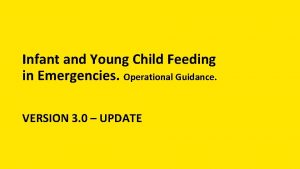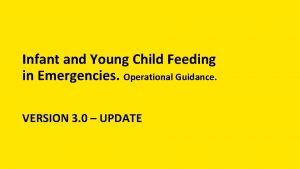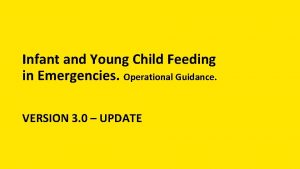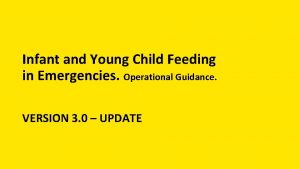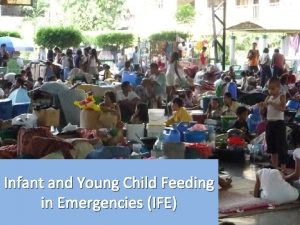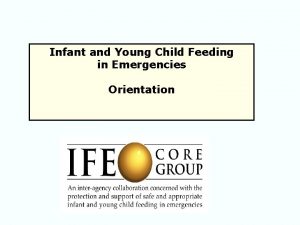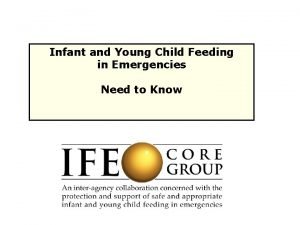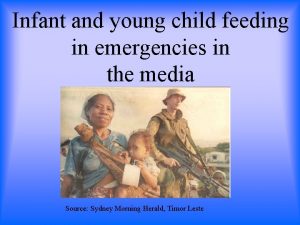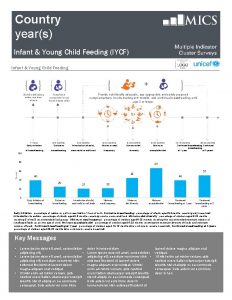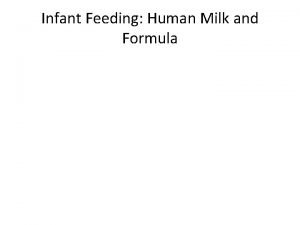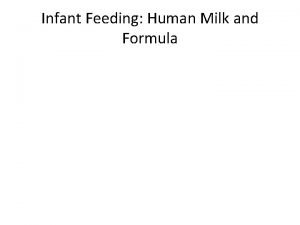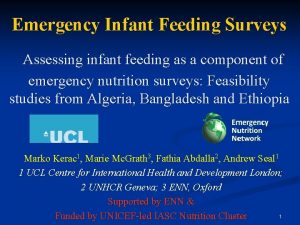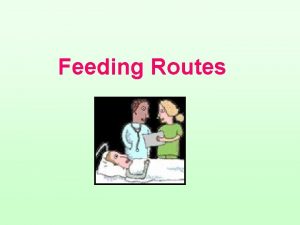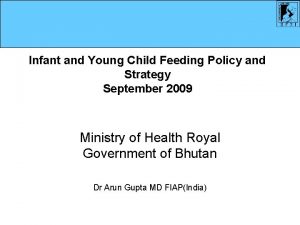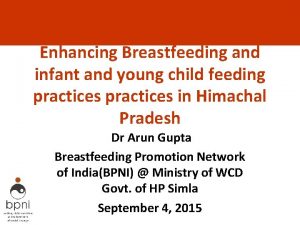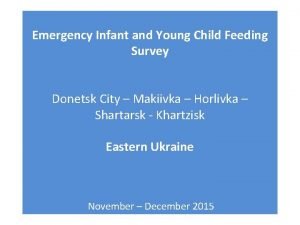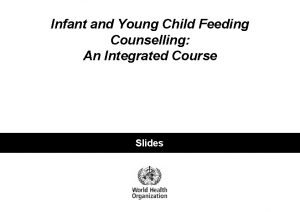Infant and Young Child Feeding in Emergencies Operational


































- Slides: 34

Infant and Young Child Feeding in Emergencies. Operational Guidance. VERSION 3. 0 – UPDATE

The Operational Guidance on IFE Aim To provide concise, practical guidance on how to ensure appropriate infant and young child feeding in emergencies (IFE) Scope Applies to emergency preparedness, response and recovery worldwide Target Groups Infants and young children aged 0 -23 months and pregnant and lactating women (PLW) Intended for Policy-makers, decision-makers and programmers working in emergency preparedness, response and recovery across sectors and disciplines.

Version 3 Updated by: Co-led: Coordinated by: Funded by: 2001 Version 1. 0 The IFE Core Group ENN and UNICEF ENN USAID/OFDA (ENN) 2006 Version 2. 0 2007 Version 2. 1 2010 Addendum ed 3 s r do ion 23. 2 n E solut e Ar WH 2017 Version 3. 0

V 3. 0 Process March 2016 • IFE Core Group Meeting: Interview findings shared, gaps in content and process agreed Feb 16 – Sept 17 Dec 2017 • Consultation IFE Core Group Experts Experiences & resources SPHERE • IFE Core Group Meeting: Dissemination & roll out action plan

V 3. 0 What has stayed the same? • Layout • Headings • Most of existing guidance • Terminology of IFE • Availability in English, French and Arabic KEY POINTS PRACTICAL STEPS (1 – 6) 1. Endorse or develop policies 2. Train staff 3. Co-ordinate operations 4. Assess and monitor 5. Protect, promote and support optimal IYCF with integrated multi-sector interventions 6. Minimise the risks of artificial feeding EMERGENCY PREPAREDNESS ACTIONS New KEY CONTACTS REFERENCES Expanded DEFINITIONS Expanded ANNEX 1: Multi-sectoral content New ACRONYMS New

V 3. 0 Revisions - Programming • Updated to reflect latest global guidance (published and upcoming) • Greater programmatic detail in all sections • Greater and more balanced content to address needs of non-breastfed infants • More comprehensive content on complementary feeding • Introduction of new concepts e. g. human milk banks • Considers situations where OG-IFE recommendations cannot be immediately met • More content on emergency preparedness • Summary key points updated

V 3. 0 Revisions – Roles & Responsibilities • Greater emphasis on the lead role of government in preparedness and response • Greater clarity on the respective roles and responsibilities of UN agencies • Greater coverage of sectors beyond nutrition and more explicit actions to take • Incorporated accountability to affected populations • Reflects significantly evolved operational environment

V 3. 0 Revisions – References, Resources, Terminology • More extensive list of supporting references and resources • Greater referencing of recommendations and definitions • More extensive list of definitions • Changes, and additions, to terminology • • • Optimal IYCF Recommended IYCF HIV Risk Assessment Donor Human Milk Bank Cluster Lead Agency Lipid-based nutrient supplement (LNS)

1: Endorse or develop policies Key provisions regarding IFE should be reflected in government, multi-sector and agency policies and should guide emergency responses. 2: Train staff Sensitisation and training on IFE is necessary at multiple levels and across sectors.

3: Coordinate operations Capacity to coordinate IFE should be established in the coordination mechanism for every emergency response. Government is the lead IFE coordination authority. Where this is not possible or support is needed, IFE coordination is the mandated responsibility of UNICEF or UNHCR, depending on context, in close collaboration with government, other UN agencies and operational partners. Where all provisions of OG-IFE cannot be immediately met, context-specific guidance on appropriate actions and acceptable ‘compromises’ should be provided by the IFE coordination authority and mandated UN agencies. Timely, accurate and harmonised communication to the affected population, emergency responders and the media is essential

4: Assess & Monitor Needs assessment and critical analysis should determine a context specific IFE response § Pre-crisis data § Rapid decision-making and action § Early needs assessment § In depth assessment § Monitoring It is essential to monitor the impact of humanitarian actions and inaction on IYCF practices, child nutrition and health; to consult with the affected population in planning and implementation; and to document experiences to inform preparedness and future response.

5: Protect, promote and support optimal IYCF with integrated multi-sector interventions Immediate action to protect recommended infant and young child feeding (IYCF) practices and minimise risks is necessary in the early stages of an emergency, with targeted support to higher risk infants and children § General § Breastfeeding support § Infants who are not breastfed – incl. relactation, wet nursing, donor human milk, BMS § Complementary feeding § Micronutrient supplementation § HIV and infant feeding § Infectious disease outbreaks

5: Protect, promote and support optimal IYCF with integrated multi-sector interventions In every emergency, it is necessary to assess and act to protect and support the nutrition needs and care of both breastfed and non-breastfed infants and young children. It is important to consider prevalent practices, the infectious disease environment, cultural sensitivities and expressed needs and concerns of mothers/caregivers when determining interventions In every emergency, it is important to ensure access to adequate amounts of appropriate, safe, complementary foods and associated support for children and to guarantee nutritional adequacy for pregnant and lactating women.

5: Protect, promote and support optimal IYCF with integrated multi-sector interventions Multi-sector collaboration is essential in an emergency to facilitate and complement direct infant and young child feeding (IYCF) interventions. Actions are included for: Health Adolescent Services WASH FSL Child Protection ECD Disability Shelter Cash Social Protection Agriculture Logistics WASH: Water, Sanitation and Hygiene, FSL: Food Security and Livelihoods, ECD: Early Childhood Development

6: Minimise the risks of artificial feeding In emergencies, the use of breastmilk substitutes (BMS) requires a context-specific, coordinated package of care and skilled support to ensure the nutritional needs of nonbreastfed children are met and to minimise risks to all children through inappropriate use § Donations in emergencies § Artificial feeding management § BMS supplies § BMS specification § Procurement of BMS supplies, feeding equipment and support § Distribution of BMS Donations of BMS, complementary foods and feeding equipment should not be sought or accepted in emergencies; supplies should be purchased based on assessed need. BMS, other milk products, bottles and teats should never be included in a general distribution.

Emergency preparedness …is critical to a timely, efficient and appropriate IFE response Examples from Box 1: Emergency Preparedness Actions POLICY TRAINING COORDINATION Develop preparedness plans on IFE Prepare orientation material for use in early emergency response Develop terms of reference for IFE coordination in a response ASSESS AND MONITOR ARTIFICIAL FEEDING MULTI-SECTOR INTERVENTIONS Prepare key questions to include in Examine national legislation early needs assessment related to food and drugs, particularly importation Communicate government position on not seeking or accepting donations

**INSTRUCTION SLIDE** The following slides cover implications of the revisions in the Operational Guidance on IFE for stakeholders involved with HIV in Emergencies. Please delete slides that are not applicable to your audience and cross reference to internal documents and processes where relevant.

Implications for…HIV is a key sector to sensitise and work with on IYCF. 5. 31 Sector programme entry points for IYCF include: antenatal and postnatal care; immunisation; growth monitoring; prevention of mother-to-child transmission (PMTCT) programmes; HIV prevention and treatment services, acute malnutrition treatment; community health; psychosocial counselling services; hygiene promotion; child protection screening; ECD activities; places of employment; and agriculture extension work. 5. 32 Examples of two-way multi-sector collaboration include: • Work with HIV prevention and treatment services to support access and adherence to ART

Implications for…HIV Pre-crisis data and early needs assessment 4. 6 Key information to consider includes contextual data: i) v) Policy environment, including relevant national guidance and preparedness plans; legal status of the Code; policies and protocols on HIV and infant feeding and other public health emergencies/infectious disease outbreaks; national food and drug legislation that affects the procurement of commodities. Prevalence/reports of higher risk infants, young children and mothers

Implications for…HIV Breastfeeding support 5. 7 Protect, promote and support early initiation of exclusive breastfeeding in all newborn infants. Integrate the Ten Steps to Successful Breastfeeding of the WHO/UNICEF Baby-friendly Hospital Initiative in maternity services. Key newborn health interventions include skin-to-skin contact, kangaroo mother care, ‘rooming in’ (keeping mothers and infants together), and delayed umbilical cord clamping. Limit supplementation with BMS to medical needs. Target support to mothers of premature and LBW infants, adolescent mothers and first-time mothers. Ensure access to HIV services as appropriate, including nutritional support when indicated. Ensure birth registration of newborns within two weeks of delivery and coordinate with other sectors (such as health, food security and social protection) to facilitate access to support services. Use and build existing capacity (such as traditional birth attendants, midwives and peers) to provide skilled breastfeeding support.

Implications for…HIV Infants who are not breastfed 5. 16 BMS requirement may be temporary or longer term. Temporary BMS indications include: during relactation; transition from mixed feeding to exclusive breastfeeding; short-term separation of infant and mother; short-term waiting period until wet nurse or donor human milk is available. Longer-term BMS indications include: infant not breastfed pre-crisis; mother not wishing or unable to relactate; infant established on replacement feeding in the context of HIV; orphaned infant; infant whose mother is absent long-term; specific infant or maternal medical conditions; very ill mother; infant rejected by mother; a rape survivor not wishing to breastfeed.

Implications for…HIV and infant feeding 5. 33 Check national/sub-national policies on HIV and infant feeding. Assess whether they are in line with the latest WHO recommendations; address emergency situations, including refugee and IDP contexts where applicable; and if necessary, support update as part of preparedness. Rapid issue of updated interim guidance may be necessary in a response where policy is outdated or to address unforeseen issues. Key emergency considerations include change in risk exposure to non-HIV infectious disease and malnutrition; likely duration of the emergency; access of refugee populations to antiretroviral drugs (ARVs) and health services; whether the conditions for safe formula feeding are available; and the availability of ARV.

Implications for…HIV and infant feeding 6. 34 In accordance with global guidance, support breastfeeding mothers living with HIV to breastfeed for at least 12 months (early initiation and exclusive breastfeeding for the first six months) and to continue breastfeeding for up to 24 months or longer while being fully supported for adherence to ART. Where ARV drugs are unlikely to be available (such as interrupted supply in an emergency), breastfeeding of HIVexposed infants is recommended in the interests of child survival. Breastfeeding should only stop once a nutritionally adequate and safe diet without breastmilk can be provided.

Implications for…HIV and infant feeding 5. 35 Support breastfeeding women who are known to be HIV uninfected or whose HIV status is unknown to exclusively breastfeed for the first six months of life and to continue breastfeeding for 24 months or beyond, in accordance with recommended IYCF practices. 5. 36 Prospective wet nurses should undergo HIV counselling and rapid testing where available. In the absence of testing, if feasible undertake HIV risk assessment. If HIV risk assessment/counselling is not possible, facilitate and support wet nursing. Provide counselling on avoiding HIV infection during breastfeeding.

Implications for…HIV Terminology: HIV RISK ASSESSMENT A process (usually a set of questions) which provides insight into the likelihood that a prospective wet nurse has been exposed to the HIV virus. A standard HIV risk assessment or score does not exist for appraisal of a prospective wet nurse. An assessment will consider HIV status of current or previous partners, practice of unprotected sex, history of sexually transmitted disease and if the woman appears to be in good health. However, even if these questions are asked, there is presently no agreed guidance on how to quantify the risk of HIV infection and what feeding practice to suggest. The decision on infant feeding practice requires a balance of risk factors that influence HIV-free survival of the child. This will include consideration of the prevalence of HIV, the likely duration of wet nursing, whether the wet nurse is in good health, HIV test history (e. g. during previous pregnancy) and other factors such as the risks of not breastfeeding and the feasibility and safety of artificial feeding in this circumstance.

Implications for…HIV and infant feeding Terminology: Replacement Feeding a child who is not receiving any breastmilk with a nutritionally adequate diet until the age at which they can be fully fed on family foods. This term is used in the context of HIV.

Implications for…HIV and infant feeding 5. 38 Work with the health sector • to identify HIV-positive mothers on ART to promote and support ART adherence and retention in treatment; • to facilitate alternative distribution mechanisms for ARVs where usual systems are disrupted; • to advocate that PLW remain a priority group for ARV distribution. A minimum HIV response requires assured, continued ARV supply for PLW known to be HIV positive and on ARVs; access to safe and clean deliveries; infant feeding counselling; and perinatal prophylaxis for HIV-exposed infants.

Implications for…HIV and infant feeding 5. 38 Provide links to existing care and support services; and access to contraceptives, malnutrition treatment services, and food or livelihood support where indicated. Treatment options should be expanded to include HIV rapid testing and counselling and initiation of ART as soon as possible. HIV test kits should be prioritised (low-cost, robust regarding storage and temperature stability, and easy to use). 5. 39 Clearly communicate with emergency responders, health providers and HIVexposed mothers regarding applicable HIV and infant feeding recommendations, such as in joint statements issued.

Implications for…HIV Protect, promote and support optimal infant and young child feeding with integrated multi-sector interventions For more information on how to work together to jointly achieve shared objectives: 1. Go to: • Operational Guidance on IFE V 3. 0 Resources – Special Circumstances • Operational Guidance on IFE V 3. 0 Resources - Infectious Disease 2. Watch: IYCF Framework

INSTRUCTION SLIDE You may find it useful to have a discussion on how the revised guidance can be dissemination within your working group / cluster / agency etc. Suggestions have been made for roll out at: 1. Individual agency level 2. National level 3. Regional level Select the appropriate slide. Suggested roll out actions will have to be contextualised prior to presenting. Following the discussion, it is recommended to set SMART objectives and work out a timeline to implement the recommended roll-out actions. Consider what resources are required to support the roll-out.

Recommendations for dissemination (Agency) • Wide dissemination of Ops Guidance on IFE within <agency> • What does this mean for you and your agency? Roles, responsibilities, agency activities, programming, strategies, position papers etc. • Training for technical staff from health, nutrition and other sectors • Sensitisation for all staff including senior management and communication, logistics, resource mobilization, rapid response and volunteer teams • Inclusion of V 3. 0 in induction reading materials, agency resource libraries, training materials etc. • Dissemination and roll out to regional, country and field offices • Update training materials

Recommendations for dissemination(National/Cluster) • Wide dissemination to <Ni. EWG / nutrition cluster members, all other sectors, intercluster, relevant government agencies and authorities, advocacy groups, policymakers> • What does this mean for you? Preparedness and response plans, roles and responsibilities etc. • Dissemination of / sensitisation on update • Translation of Operational Guidance on IFE text into local language • Adaptation of Operational Guidance on IFE to local context • Incorporation of V 3. 0 revisions into national guidance & policy • Inclusion into background reading materials

Recommendations for dissemination (Regional) • Wide dissemination of Ops Guidance on IFE at <regional level> • What does this mean for you? Preparedness and response plans, roles and responsibilities etc. • Training and sensitisation for regional offices • Translation into regional languages • Dissemination to country offices • Incorporation of V 3. 0 updates into regional strategies, funding etc.

Appropriate and timely support of infant and young child feeding in emergencies (IFE) saves lives, protects child nutrition, health and development and benefits mothers.
 Infant driven feeding readiness scale
Infant driven feeding readiness scale Enteral parenteral beslenme
Enteral parenteral beslenme Berk 8th edition
Berk 8th edition Lesson 6: cardiac emergencies and using an aed
Lesson 6: cardiac emergencies and using an aed Endocrine and hematologic emergencies
Endocrine and hematologic emergencies Emt chapter 18 gastrointestinal and urologic emergencies
Emt chapter 18 gastrointestinal and urologic emergencies Chapter 28 first aid and emergencies
Chapter 28 first aid and emergencies Picme2.0
Picme2.0 Preschoolers often have trouble buttoning shirts
Preschoolers often have trouble buttoning shirts Hbyc training module in marathi
Hbyc training module in marathi Child workers some as young as 10
Child workers some as young as 10 Local area orientation dive
Local area orientation dive Chapter 16 respiratory emergencies
Chapter 16 respiratory emergencies Major nutritional deficiency diseases in emergencies
Major nutritional deficiency diseases in emergencies Environmental emergencies emt
Environmental emergencies emt Chapter 23 gynecologic emergencies
Chapter 23 gynecologic emergencies During a psychiatric emergency the emt should be able to
During a psychiatric emergency the emt should be able to Chapter 18 neurologic emergencies
Chapter 18 neurologic emergencies Chapter 16 respiratory emergencies
Chapter 16 respiratory emergencies Pumberton sign
Pumberton sign Chapter 35 geriatric emergencies
Chapter 35 geriatric emergencies Chapter 13 handling emergencies
Chapter 13 handling emergencies Chapter 12 behavioral emergencies
Chapter 12 behavioral emergencies Chapter 32 environmental emergencies
Chapter 32 environmental emergencies Chapter 17 cardiovascular emergencies
Chapter 17 cardiovascular emergencies Psychiatric emergencies
Psychiatric emergencies Qut security emergency extension number
Qut security emergency extension number Immunologic emergencies
Immunologic emergencies Chapter 17 neurologic emergencies
Chapter 17 neurologic emergencies Left child right sibling tree
Left child right sibling tree Keeping an infant safe and well section 7-3
Keeping an infant safe and well section 7-3 Kenmore park infant and nursery school
Kenmore park infant and nursery school Keeping an infant safe and well section 7-3
Keeping an infant safe and well section 7-3 Saguaro infant care and preschool
Saguaro infant care and preschool Sparhawk nursery
Sparhawk nursery
